Behind Closed Doors; Out of Sight, Out of Mind
Factory Farming in Photos
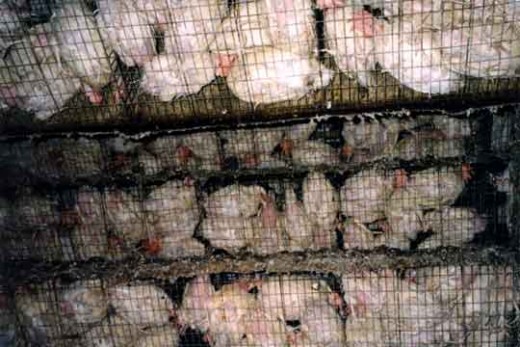
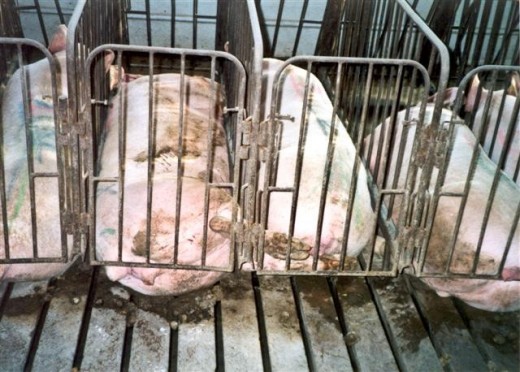
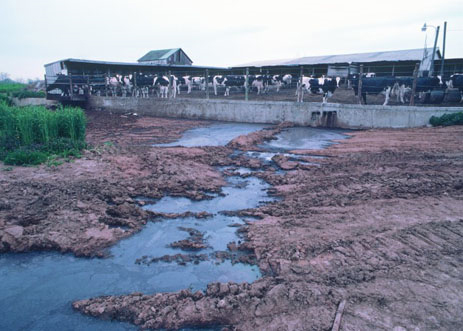
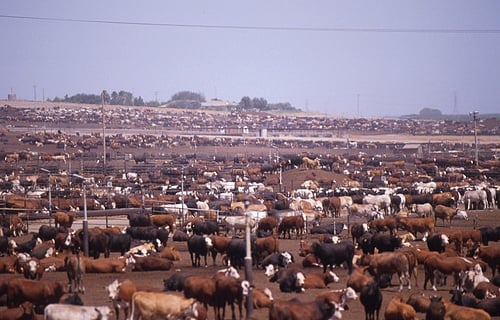
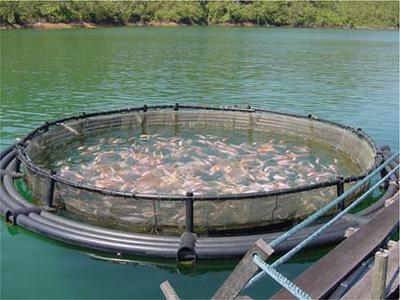
Animal Concentration Camps
We have meat that you can eat! Take your pick! The shelves of every supermarket and delicatessen that you care to find and gaze longingly into has meat galore in any style you like. We see pictures plastered everywhere. The ads are in papers, on TV, the sides of buildings, elevator display screens, buses and trains. On the buses, ads are on the floor, the walls and ceilings. We are encouraged to super size that burger and our mailboxes are crammed with expensive glossy ads for every conceivable restaurant with meat offerings. It is a carnivores paradise! Most of us select our meat choices with hardly a second thought as to where it came from and what is in it. It is as if meat grew on trees ready for the picking like a ripe apple. But this is far from the case. We need to have a much closer look!
Not so long ago, people who wanted meat, had to do like the carnivores, hunt, stalk, kill and then eat. In the beginning, all meat was wild and likely eaten raw, just as Inuit still do today if they live in the traditional ways. Over time, hunters got more efficient and started to preserve meat for lean times. Preserving meat included salting, curing in a smoke house, drying and natural freezing during the winter months. It is not too clear when animal husbandry was established in civilized history, but we do know that various animals that were originally wild, were domesticated for the use of humanity. Among the first was the wolf, the remote ancestor of most larger dogs. After this were animals like chickens, sheep and goats. Cattle, elephants, horses and cats came much later in the domestication process. Typically, the process employed the adoption and raising of orphaned babies and raising them in the human community. Domesticated animals were at first free roaming as the people where and they wandered together. With the advent of agriculture, some 6,000 years ago by current estimates for the current cycle, people became more sedentary and the concept of land holdings took root. Domesticated animals that were under the control of people at that time also became sedentary. From that time forward, some were put to work to plow fields or to work water wheels, grind gain and corn and the like. This was more of less the norm until the advent of the industrial revolution and the steam age. Increasingly, machines took over the agricultural side of planting and harvesting. The use of cattle and horses dropped off in favor of steam of gas driven tractors, planters and harvesters. Cattle were to find a different use.
Mono-culture farming has a strong appeal because vast tracts of flat or flattened land can be planted, managed and harvested by machines run by a handful of people. This kind of farming is what is at the core of agri-business and it is immensity profitable and powerful. It did not arise overnight, but developed over the decades as techniques improved and holdings spread with the bankruptcy of small farms. Mono-culture farming covers the gamut from corn farming for bio-fuels, eucalyptus for toilet paper, to massive factory farming of food animals. The business of modern mega-farming of animals in the factory farm system is aided by anti-biotics and growth hormones that all wind up in our bodies in a process similar to biological magnification. Increasingly, engineered solutions such as the use of genetically modified organisms are being used in place of more traditional methods. This has unknown results in the long run, but we can say that yesterday's solutions became today's problems and today's solutions will become tomorrow's problems.
Problems arise from anti-biotic overuse and growth hormones. The overuse of anti-biotics has led to the evolution of multi-spectrum resistant bacteria and viruses (MSRI) for which there is now no known cure and has now spread to the wild, meaning that it is now everywhere. Growth hormones also have their negative influence on our bodies, the extent of which is not entirely clear at this time other than the fact of emasculation and female infertility. There is a spill over into the wild as well that has harmful effects on species such as reptiles and amphibians, many of which are now endangered due to gender confusion. It is becoming increasingly clear that changes are necessary to preserve what is left of the soil, the health of animals and our own health.
Consider the crocodile or the leopard. They have to kill in order to eat. People do the same thing, but this is a mere quantitative difference between species. The crocodile or leopard stalks, kills and eats its prey all in flowing continuity, one act following in sequence after another until the prey is completely devoured. The qualitative difference arises in the fact that the crocodile and leopard kill swiftly and efficiently, motivated by hunger and the need to eat. People will farm animals and slaughter them for the purpose of eating and manufacturing goods. The difference is one of methodology to accomplish the same ends. In the animal kingdom there is no desire beyond the end of feeding such as control, domination and exploitation. People on the other hand kill and that is not always to eat. People kill one another and even kill animals for trophies or mere sport. Historically, invading Europeans killed off the bison to engineer a famine against the plains Indians. Alien cattle were imported to replace the bison and these were managed on large ranch spreads in former First Nations territories. The conquerors also deliberately spread diseases like smallpox, tuberculosis, influenza, measles and alcoholic addiction. People dominate, exploit and control one another as well as the rest of the animal and plant kingdom. To do this, they employ a host of practices to accomplish their goals including subterfuge, deception and the like. People do not always kill in order to eat. Sometimes it is to prevent others from eating and this is not restricted to the killing of food animals, but destroying plant crops as well. A modern twist on this theme is the move toward the absolute control of the food supply by a single large trans-national corporation using patent laws to control farming through seed distribution. Seeds can be genetically programmed to accomplish the wish of the controlling corporation. The potential for using food as a WMD (weapon of mass destruction) is high. Considering historical practice in this regard and it is easy to see how it could be done.
In the developed world we now have factory farms for just about every species that we use for food and clothing. Typically, these food manufacturing facilities house thousands or hundreds of thousands of individual animals destined to the countries fast food, restaurants and supermarket outlets for meat. These captive animals are housed in confining pens and in many cases force fed to gain the maximum amount of weight. In most cases, the animals cannot move around and exercise. They are forced to live in their own waste as there is no efficient system to collect this randomly accumulating by-product of meat production. People who live close to pig factory farms always complain of the overwhelming stench. When a natural disaster strikes, some of these farms are destroyed and many of the animals are killed, adding further to the problems of these concentrations by way of stench and disease. As stated, every conceivable food animal is raised in such institutions today on the outskirts and sometimes within the confines of cities.
Battery hens are raised in several tiers of pens stacked vertically. These are wire cages with no solid floors, so the egg laying hens have nothing solid to stand on. In addition, the feces of the top cages falls through to the hens in the lower cages. The bottom cages are the filthiest, but the top ones are not much better. To prevent the hens from pecking one another, the beaks are sawed off on the end. Once the hens have dropped in their egg production, typically after a few months, they are culled and slaughtered for the chicken meat industry. They are taken out, cage and all, placed on a flatbed truck and taken to a decontamination facility to be washed en masse. After this, they head straight to the slaughterhouse. At that location, they are removed from the cages and hanged upside down on a conveyor chain to be carried helplessly to the first worker whose job is to stun the birds. The next one decapitates the birds head and so on down the line to a boiling bath to loosen the feathers for easy plucking. Not all birds are unconscious after the stunning. Although there are regulations about all of the process including the culling out of diseased animals, this is often ignored for the sake of efficiency and profitability.
Geese in some case, along with male calves share a terrible fate. Both are force fed so that geese grow large livers for pate and veal calves produce tender white meat. Neither are allowed to exercise and for veal calves, there is no iron in their diets and they end up anemic. These anemic individuals try to get iron by attempting to eat parts of their restraining cages. In both cases for their short lives, they live in a state of constant torture, to end up in the slaughter line like chickens.
Every Thanksgiving and Christmas, we are sold on turkeys. These are raised in huge barns in the tens of thousands all in one growing space. At killing time, they are rounded up and captured by workers, penned and shipped to local slaughter houses via large trucks. These trucks are characterized by breathing holes on all sides. Once at the slaughterhouse, they are handled in much the same manner as battery hens.
Pigs are also raised in confined pens inside massive barns. The stench of such places is unbearable to surrounding residents. As a result, these are located away from major cities and down wind. With such crowding, disease is a great risk and diseases that can jump from hog to human is a constant danger. Factory farmers have a preemptive solution by the way of anti-biotics, but the overuse of this has lead to the evolution of the super bug for which there is no treatment. Matured pigs have to be shipped from the factory farms to slaughterhouses in the cities where they are processed. They have to endure a long and uncomfortable ride to their fate.
Cows and bulls require a lot of space typically, but increasingly, these are being raised in similar conditions as pigs. They are fed on diets that are not specific to their biology. This sometimes even consists of meat or organs that people won't eat. It is thought that the feeding of cattle, food like sheep and goats brains has lead to the development of prion disease that can be passed to people and lead to spongiform encephalitis, a debilitating, incurable and fatal brain wasting disease in people.
Within the last few decades, factory farming of fish like salmon along the coastlines of continents has become a booming industry. As wild salmon stocks fail due to over fishing and the damming of their river runs as well as sea lice passed from their farmed counterparts, there is an increasing reliance on factory farmed salmon. Other species are being added to this relatively new form of factory farming.
There is a growing awareness of this kind of practice, but instead of it being eliminated, the producers simply pull up stakes and relocate to countries where there is no awareness and no controls. There are few enough controls in our own regions where the drive for profit is a desperate dash to avoid the counterpart; bankruptcy and ruin. Many large factory farms live on the thin edge of economic catastrophe. Thus there is an incentive to cut costs by any means possible. The cost is the suffering of the animals throughout there lives and the toxification of their meat as a result of constant stress. Animals need to be free range as nature intended. In addition, people need to sharply reduce the amount of meat consumption just for questions of planetary agricultural sustainability alone. A boycott of factory farming products would send a message to practitioners of this method of raising meat. All of this will require full knowledge on the part of the people and a revolution in action. We object to housing people in concentration camps; we should do the same for animals who have supported us throughout our history. It is a matter of basic respect, the kind of respect that First Nations held for the animals in their world.
Pigs on the way to the slaughterhouse
More Shocking Stuff of Serious Animal Abuse. Some of these Animals know what's coming!
2 Links: In defense of Animals: Beware, Not everything is as stated
- Animal Voices Radio Show | in Vancouver
in Vancouver there is a radio show that deals with all questions relating to our animal friends. Give it a listen when nearby. - Organic-wash
It's really hard to know if this is organic, "traditional" or GMO. About the only guarantee is if you grew it yourself! Not everything that you eat with the label organic is in fact organic. It...




